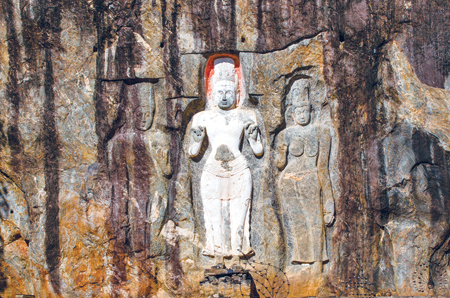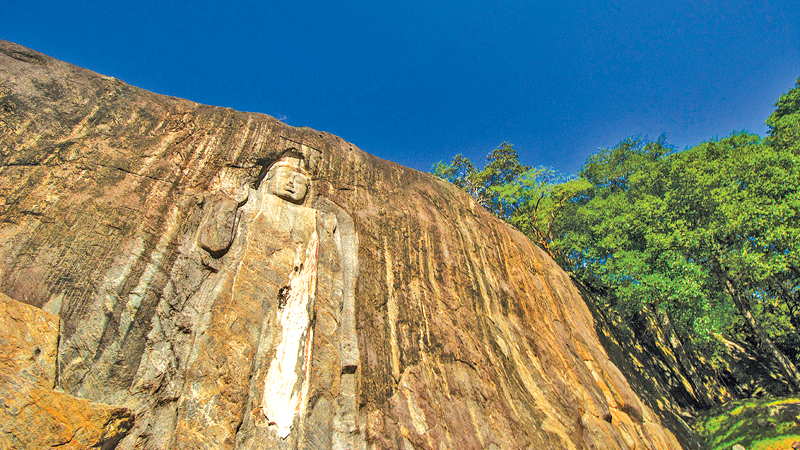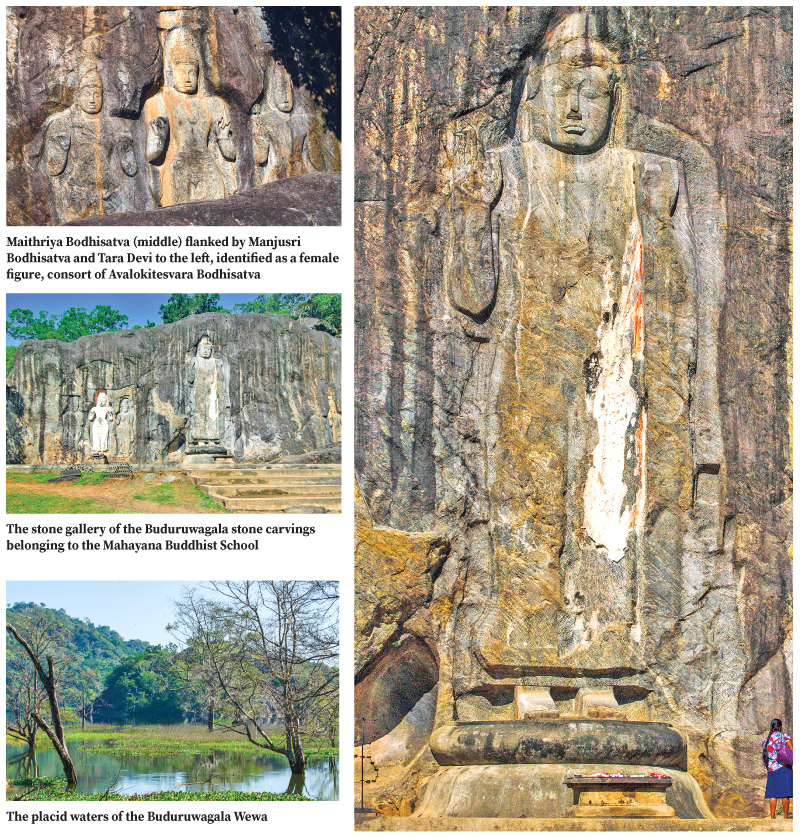MAHAYANA SITE OF BUDURUWAGALA-by Mahil Wijesinghe
Source:Sundayobserver

“Wary of guides, I always preferred to look at ancient sites for myself rather than through a haze of verbiage. In this instance what my eye look afresh, was something more like fantasy of colossal figures carved on the base of rock which rose to a height of 70 feet. They were giant size, upright human figures which in their eerie forest setting and with the marks of weathering they had undergone through a thousand years or more by exposure to the elements, produced a subtle aura of reverential wonder.”
“The central panel was dominated by a gigantic statue of the Buddha sculpture in high relief on the natural rock with details finished off in stucco. This Buddha statue rose to a height of 51 feet – nearly 13 feet higher than better known Buddha image of Avukana and Sessuruwa in the Raja Rata. The image appeared to have been coated with paint at a very distant date, traces of which were yet visible. These images and more especially those panelled on the left of the image of the Buddha are without a peer of a high degree of artistic merit. The site is of the Mahayana period of worship.”
That was a vivid description of the Buduruwagala rock image carvings, as stumbled upon by Dr. R. L. Brohier, in his dire quest for hidden treasures of our forgotten heritage way back in 1926 as described in his “Discovering Ceylon”.
We too on hearing of these forgotten relics of Buduruwagala which speak of Mahayana Buddhism that had existed at the time, set out along the Colombo-Galle-Matara-Tissamaharama-Tanamalvila- Wellawaya road.
As told by Dr. Brohier in his “Discovering Ceylon”: “Today devotees, the scholar, or the more serious traveller who in search of Sri Lanka’s ancient culture does not travel the hard way to see Buduruwagala which happily still occupies its forest setting. A 2.5 kilometre track motorable in dry weather, which turns West near 194th mile post on the Wellawaya-Hambantota road leads to it.”
Open stretches

The crowned figure at the centre of the group is thought to be Maitreya, the future Buddha. To his left stands Vajirapani, the figure to the left may be either Vishnu or Sahampath Brahma
I too on several occasions in recent times, went along this roadway off the 194th mile post flanked by farmers’ huts, cottages and some modern houses. It’s filled with fine open stretches of vast plains punctuated by forest trees, paddy fields, chena, denuded forest and the most awe-inspiring spectacle which is its mountain frontier.
The prominent Vadinahela mountain range rises loftily standing like a sentinel which could be viewed from all directions. Amid this forested mountain frontier, stands in all its serenity the Buduruwagala tank which had been restored in the past years. It waters the rice fields worked by the peasantry.
The profiles of the Poonagala, Namunukula, Bandarawela hill range and Ella gap loom over these frontiers. Before us stood a rock boulder in the shape of an elephant’s back with its protruding head. Set beside this were these wonderful figures in groups in real pose. In the middle of the figures, stands a Buddha statue carved out of its boulder which appeared to have been sculptured in high relief in stucco. When observing these figures, these carvings stand in a stone gallery of rock icons in separate groups.
To the right of this Buddha statue, is the largest carving of Bodhisatva (manifesting the doctrine of Mahayana Buddhism representing Avalokitesvara). The panel of its left side symbolises Maitriya – Maitri Bodhisatva, identified to be Sudhana Kumaraya. The other figures in this panel of figures are those of Manjusri Bodhisatva and Goddess Tara Devi supposed to be the consort of Avalokitesvara.
Vajirapani is also identified as one of the female figures. Goddess Tara Devi is mentioned in the Mahayana Tantric doctrine which had their origins in India. From this rock gallery of carvings of human figures, it is seen that each of the Bodhisatvas is flanked by a female companion on one side and a male on the other side.
Bodhisatva Avalokitesvara
Bodhisatva Avalokitesvara is symbolised by the Dhyni Buddha Amitabbha in head-dress as evident in this icon which appears on the right hand side of the Buddha statue. There had been some paintings coated in the figures of the Bodhisatvas and the female figures.
Dr. Nandadeva Wijesekera, in his “Early Sinhalese Sculpture”, says of this paint coating on the figures seen at Buduruwagala: “Some of the details of the figures are completed in stucco which were originally painted.”
Vandals had wreaked havoc, destruction and desecration to many cultural and Buddhist artefacts unearthed in the jungle. Dr. R.L. Brohier, who stumbled upon these relics of Buduruwagala, found that the objects had been plundered (that was in 1926): “But the conspicuous feature the eye rested on was the evidence of vandalism by treasure seekers. Near the feet of the statue, the rock had been blasted and scooped out leaving an ugly gaping carving.”
It is a pity that the feet of the statue are still broken in to two and lying at its base in that melancholy and destructive state as it was nearly 100 years ago, as had been seen by Dr. Brohier. The first person to rediscover Buduruwagala when it was in the folds of the entwining jungle was Dr. R.L.Brohier in 1926, then only was it brought to the notice of the Archaeological Department which was then headed by the late Dr. S. Paranavithane.
Dr. Paranavithane had made glowing tributes to Dr. Brohier for his rare finds at Buduruwagala which drew the attention of his department to the restoration and further research into the Mahayana cult.
The school of Mahayana Buddhist doctrine crept into ancient Sri Lanka surreptitiously imported from India between the 4th and 9th century AD. Even before these periods, attempts were made to introduce the Mahayana cult to Sri Lanka, but due to the foresightedness of the ruling kings then, these were suppressed. According to archaeological sources, the Buduruwagala statues date back to these two intermittent periods.
We see again gleanings taken from our historical records and other chronicles, during the reign of King Mahasena (274/302 AD.), when the conditions for the preservation of Theravada took a different turn from bad to worse.
Theravada Buddhism
Under King Mahasena’s period of reign, the Maha Vihara buildings were destroyed and even the bhikkhus there were persecuted. Later there was an uprising by the people against the propagation of the Mahayana doctrine and the king had to submit himself to the will and wishes of his subjects. Thereafter, Theravada Buddhism was restored to its rightful place.
Theravada Buddhism even after the 4th century AD had its ups and downs. During Mahasena’s reign, he had built another Vihara called Jetavana in Anuradhapura close to the Maha Vihara premises. Hence there existed now three monasteries Maha Vihara, Abeyagiri and Jetavana.
During this period, successive kings mostly paid obeisance to the Maha Vihara. There the Theravada doctrine was deeply rooted, while the other kings paid homage to the other Vihara which taught the concept of the Mahayana.
During the regnal years of King Silakala (524-537) AD., even those sects which proclaimed Mahayana preaching turned to Theravada, and accepted it. Thereafter, the Mahayana doctrine was nullified and declared unacceptable.
According to archaeologists at the time, it is recorded that the concept of the Mahayana doctrine existed only between the 4-9th century AD. So, Buduruwagala in Wellawaya in the Uva Province is one of the most historical sites in the country which gives evidence to the Mahayana Buddhist School.









